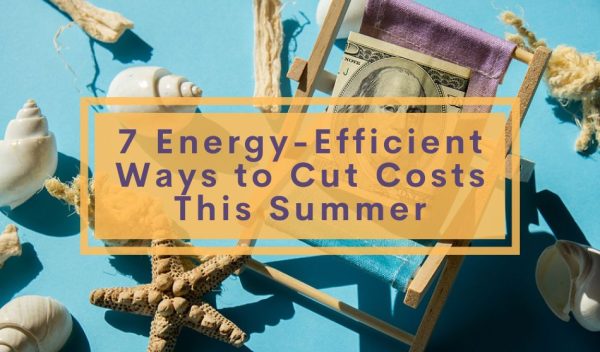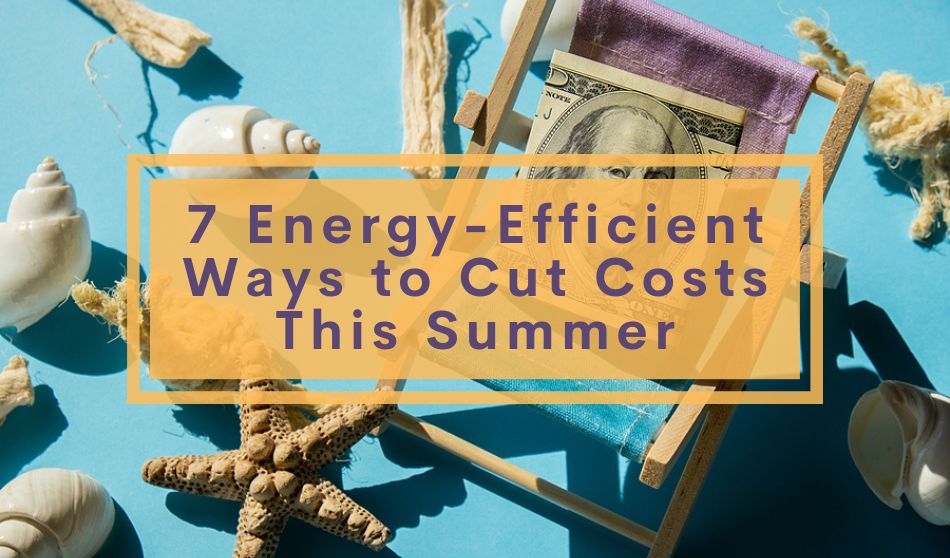
Summer is finally here, and for many of us, that means vacations, trips to the beach, and backyard barbecues. However, with summer also comes higher energy bills. With temperatures on the rise in the summer months, maintaining a comfortable temperature inside your home often comes at a price. After all, air conditioning isn’t cheap.
Fortunately, there are some easy ways you can cut down on your energy usage this summer and trim down on your cooling costs without having to suffer through uncomfortably hot days and nights in your home.
In fact, if you begin making your preparations now, you’ll be able to start the summer off saving a few hundred dollars. Here are seven energy-efficient solutions to reducing your energy costs in the summer months:
1. Give Your AC a Checkup
One of the first and most important things you should do before summer kicks it into high gear is to give your air conditioner a thorough checkup to make sure it’s functioning as optimally as it should. Simply cleaning a clogged filter in your AC unit can save up to fifteen percent in energy usage and will help it work better so it won’t break down. However, if your A/C is more than 10 years old, it could be time to replace it with something new.
2. Use Ceiling Fans
You may not realize this, but ceiling fans can work wonders for keeping a room cool without having to rely so much on your A/C unit. While they don’t actually cool the temperature of a room, ceiling fans can make it feel cooler simply by moving the air around. This cooler air evaporates the perspiration on our skin, creating the wind chill effect that makes a room feel cooler without changing its actual temperature.
Ceiling fans use considerably less energy than A/C systems do and, when used in conjunction with each other, they can help increase comfort and save energy costs. With both your ceiling fans and A/C running at the same time, you’ll be able to increase the thermostat by a few degrees without sacrificing on your comfort. In turn, your A/C will run less frequently, lowering your energy costs overall. Make sure to set your ceiling fan blades to counterclockwise so that they push cooler air down to the floor.
3. Add Window Treatments
Your air conditioning system works hardest in rooms with windows where the sun is allowed to shine in, creating a greenhouse effect that makes rooms warm and uncomfortable. A simple solution is to install window blinds or shades if you don’t already have them hanging in your home.
There are a variety of options for you to choose from, including room-darkening window treatments that can help reduce some of the light and warmth that gets into your home. If you’re really trying to save on cash, consider purchasing budget-friendly window coverings. To get the most energy savings out of your window treatments, make sure you keep them closed when the sun is at its warmest—usually between the hours of 10 a.m. and 4 p.m.
4. Unplug Electronics
Most people don’t realize how much energy they’re using simply by keeping appliances and electronics plugged in while they’re not being used. Television sets, DVD players, computers, and anything with a clock or light that stays on when the device is powered off can drain power and waste energy. This doesn’t mean you have to go around your home plugging and unplugging all of your electrical devices all the time. Instead, you can plug your electronics into surge protectors or use outlets that connect to wall switches. This way, when these are turned off, there’s no power to drain.
5. Add Insulation
You know that insulation can help keep your home warm during the cold winter months, but did you know that it can also keep your home cool in the summertime as well? Most people don’t realize that insulation can help reduce the heat gain that is absorbed through the surfaces of their home, preventing the warmth from the outdoors from entering through the roof, attic, walls, and floors.
By ensuring that your home is properly insulated, you can block warm air from getting in and cool air from escaping when it’s hot out, so you won’t need to crank your A/C unit up just to maintain a comfortable temperature inside.
6. Load the Washing Machine
Whether your dishwasher and washing machine are full or not, they’re still using the same amount of water and energy when they’re running. When washing clothes or running the dishwasher, use full loads so you get a lot more for your money—and run the machines less often. Another tip for using your washing machine and dishwasher more efficiently and cut costs is to avoid using hot water whenever possible. Did you know that a large percentage of the energy used by your washing machine goes toward heating the water? You can save a tremendous amount of energy simply by doing your laundry on either the cold or warm cycle.
For added energy savings, taking advantage of the warm weather and dry your clothes outdoors instead of putting them through the dryer. By doing this, you’ll save energy, cut costs, and help prevent raising the temperature inside your home through heat-generating appliances.
7. Tint Your Windows
You’ve heard of tinting your car windows to block out the sun and keep the inside of your car cooler, but did you know you can do this with the windows in your home, too? Adding a window tint (also known as a window film) can help you save a ton of money and stay cooler at the same time. Often applied to the interior windows, window tints can help block ultraviolet light from entering your home, allowing you to better control the temperature inside and improve your home’s energy efficiency.
This article was originally published in July 2019 and has since been updated.







I’ve posted comments but they don’t get answered probably cuz i have not paid and will not till I c a proper answer no my questions
Hi Lisa, Sorry if you missed the reply, but we did see your comment. You can find it here. Based on this and the details in other comments, I would certainly recommend contacting your local housing authority as they would be able to confirm the details of your situation and advise you on what further steps you can take. Best of luck!
Thank you for sharing these tips! If you have a swimming pool, you may also be wondering how you can reduce your energy costs on maintenance. After all, pools consume a lot of energy. Here are some tips for you:
1. Purchase a smaller, more efficient pump;
2. Lower your pool’s temperature.
3. Choose an energy-efficient heater;
4. Maintain your pool’s filter and cleaning system;
5. Invest in automated pool features.
Thanks for joining in the discussion. I’m sure readers will appreciate your helpful tips and insight!
You made a good point about replacing old air conditioning units. Even though replacing appliances might seem expensive, having old appliances is even more costly. For example, if you have an air conditioner that is more than 15 years old, it most likely requires frequent repairs. As a result, it will cost you more in the long run to repair it than if you replaced it with a completely new system.
Yes! Such a thing as a clean air conditioner filter can make a big difference. And here are the signs that your filter needs changing: different color of the filter, high energy bills, low air flow, allergy symptoms.
Thank you for such an amazing article! Another thing homeowners may want to consider to cut energy costs in summer is installing solar panels.
While installing solar panels may seem expensive, homeowners can qualify for a tax credit that will greatly reduce the payback period of the panels. For systems installed in 2023, homeowners can claim 22% of qualifying installation costs as a tax credit.
Hi Edelman,
Yes! While, it may not be for everyone, solar can be a good option for landlords who want to offer some extra amenities, lower utility costs, and stand out from competition as an eco-friendly rental.
Also, consider upgrading your HVAC system with a new energy-efficient option. When upgrading your HVAC system, look into appliances with a high SEER rating — these ones are more energy-efficient. Also, please remember to check the new HVAC regulations for 2023. These changes are legally effective from January 1 this year.
Here’s another fantastic tip to save energy (and money!) with minimal effort: just adjust your thermostat slightly. Set it to 75°F when you wake up, 80°F when you leave, 75°F in the evenings, and 78°F (or turn it off) when you sleep. You won’t feel a big change in temperature, but you’ll see a significant reduction in energy usage.
Agreed! Adjusting the thermostat can lead to big savings over time as long as your system doesn’t have to work too hard to make up the difference. While you can certainly do it manually, getting a thermostat that is programable can ensure you don’t forget.
Window tint is actually a good thing. However, not everyone likes how it looks and is going with the interior of their houses. So I want to mention such a thing as low-e glass that reflects heat, instead of allowing it to be absorbed and transferred through the material. Many people confuse tinted windows with low-e glass coatings, but tinted windows only block light, they don’t reduce heat transfer like low-e glass. And what’s also great is that low-e glass windows have a coating that is completely transparent and microscopically thin.
Thanks for adding your insight, Portella!
Before the hot weather arrives, you might want to think about getting a new air conditioner. Even though it can be expensive to buy and install a new unit, using an old and inefficient air conditioner can lead to much higher energy bills and constant repairs. So, if your AC is 10 years or older, it’s a good idea to consider getting an a replacement. It may cost more upfront, but it can save you money in the long run and give you a more efficient cooling system.
In addition to window treatments, consider using thermal curtains or drapes that are designed to block heat transfer, helping to keep your home cooler in the summer.
That’s a good point. However, if you have radiators below your windows, thermal curtains may have the opposite effect as the thick material of curtains won’t let the heat from distributing throughout the room efficiently. In this case, it’s best to opt for thermal curtains that stop where the radiators start.
Thank you for the added context and tips, Glenn!
Thanks for bringing up the importance of changing air filters. Changing or cleaning the air filter is a relatively simple task that most homeowners can do themselves. To do this, just check the HVAC system’s manual for guidance on how often to change the filter and the specific type of filter to use.
Regarding filter types, a filter with a MERV rating between 6 and 13 is usually fine for most homes. Filters with a higher MERV rating can make your system work harder and use more energy, so it’s best to avoid them unless your system specifically needs them.
Also, consider investing in a smart thermostat for your home. Smart thermostats can learn your daily routine and adjust the temperature accordingly, ensuring you’re not overcooling your home when it’s not needed. They can also be controlled remotely, allowing you to turn down the AC when you’re away and back up when you’re on your way home. This can result in significant energy savings.
Checking for water heater leaks is a crucial step in conserving heat energy at home. Not only do water heater leaks contribute to water wastage, but they also result in energy wastage. The constant need to heat new water to replace the leaked hot water can significantly increase your energy bills and carbon footprint.
So, in your quest to make your home more energy-efficient, don’t forget to inspect and promptly repair any water heater leaks – it’s a small step that can lead to big energy savings.
Yes, replacing HVAC filters is key for a home’s energy efficiency, so I’m glad you mentioned it. Very often, dirty filters become a reason for various problems with the system. Sometimes homeowners even think they need an HVAC system replacement, when all they need first is to change the filter and monitor. I recommend changing filters once every 60-90 days. To check if your filter needs replacement, just take a quick look at it. Dirty filters look gray and clogged, and you might even see dust and debris visibly accumulated on the surface. A clean filter, in contrast, will be white and free from debris.
Helpful reminder on AC prep for summer! An additional quick tip: Ensure the area around your outdoor AC unit is clear of debris and leaves. This enhances airflow and efficiency, preventing overexertion and potentially extending the unit’s lifespan, especially in older systems.
Hey there! Also, don’t forget about giving your AC’s evaporator coil a good clean. A dirty evaporator coil can reduce your AC’s efficiency, making it work harder and drive up your energy bills, especially during those hot summer months. You can gently clean the coil with a soft brush or use a no-rinse coil cleaner available at most hardware stores. It’s a quick job and can save you a lot on cooling costs!
And one more tip to keep your home cooler and reduce your energy bills this summer is to install low-flow showerheads and faucet aerators. These devices reduce the amount of hot water you use without sacrificing water pressure, meaning your water heater doesn’t have to work as hard or as often. This not only conserves water but also decreases the energy needed to heat it, which can lead to noticeable savings on your gas or electric bill. Plus, they’re easy to install and inexpensive, making it a quick and effective upgrade for any homeowner looking to save on cooling costs.
This article is great! Thank you. I want to add one more tip regarding reducing energy consumption. While many people think it’s best to turn off the AC completely when leaving home for a few hours, in reality, it’s more efficient to adjust your thermostat instead. Set your thermostat to a higher temperature when you’re away (around 85 degrees) and then lower it back to your comfort level when you return. This approach avoids the energy-intensive process of cooling down a significantly heated home, which can be more taxing on your AC system and lead to higher energy usage.
This is an incredibly helpful and timely article! The energy-efficient tips shared here offer practical ways to not only cut down on costs but also reduce our environmental impact during the hot summer months. I especially appreciate the emphasis on simple, actionable steps like using ceiling fans and optimizing thermostat settings. These are often overlooked but make a huge difference. The suggestion to invest in energy-efficient appliances is also a smart long-term solution. Thank you for putting together such an informative and easy-to-understand guide!